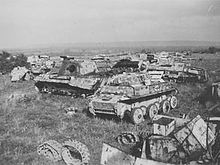Operation Tractable
Although the Falaise Gap was narrowed to a distance of several hundred metres, by attacks and counter-attacks between battle groups of the 1st Polish Armoured Division and the II SS Panzer Corps on Hill 262 (Mont Ormel) the gap was not closed quickly and thousands of German troops escaped on foot.[2] Following the failure of Lüttich, the town of Falaise became an objective of the Commonwealth forces, to cut off virtually all of Army Group B (Generalfeldmarschall Günther von Kluge).[4] Totalize would rely on a night attack using the new Kangaroo armoured personnel carriers to achieve a breakthrough of German defences supported by US heavy bombers the next day.[5] By 10 August, Canadian troops had reached Hill 195, north of Falaise, but needed another set-piece attack to overcome the German defences.[6] Field Marshal Bernard Montgomery hoped that Canadian forces would achieve control of Falaise by midnight on August 14.From there, all three formations would advance towards Trun, 18 km (11 mi) east of Falaise, with the additional assistance of the 1st Polish Armoured Division, numbering approximately 10,000 men.[6] As a result, the 12th SS Panzer Division placed the bulk of its remaining strength—500 grenadiers and 15 tanks, along with twelve 8.8 cm PaK 43 anti-tank guns— along the Allies' expected line of approach.[6] Throughout the day, continual attacks by the Canadian 4th and Polish 1st armoured divisions managed to force a crossing of the Laison River.Limited access to the crossing points over the Dives River allowed counterattacks by the German 102nd SS Heavy Panzer Battalion.[12] By the end of the first day, elements of the Canadian 3rd and 4th divisions had reached Point 159, directly north of Falaise, although they had been unable to break into the town.[13] Although the first day's progress was slower than expected, Operation Tractable resumed on 15 August; both armoured divisions pushed southeast toward Falaise.[15] After harsh fighting, the 4th Armoured Division captured Soulangy but the gains made were minimal as strong German resistance prevented a breakthrough to Trun.Simonds began to reorganize the bulk of his armoured forces for a renewed push towards Trun to close the Falaise Pocket.[19] As Canadian and Polish forces liberated Trun, Maczek's second armoured battlegroup manoeuvred southeast, capturing Champeaux and anchoring future attacks against Chambois across a 10 km (6 mi) front.By the evening of 18 August, all of Maczek's battlegroups had established themselves directly north of Chambois (one outside of the town, one near Vimoutiers and one[nb 2] at the foot of Hill 262).[21] With reinforcements quickly arriving from the 4th Canadian 4th Armoured Division, Maczek was in an ideal position to close the gap the following day.As the link occurred, the II SS Panzer Corps had begun its counterattack against Polish forces on Hill 262, to reopen the pocket.[24] With American and Canadian forces facing German counterattacks in their sectors, the Poles had to defend against two veteran Panzer divisions to keep the gap closed.By mid-morning, 2,000 survivors of the German 2nd Parachute Division had managed to breach Canadian positions along the Dives River and at Point 117.[26] By mid-afternoon, reinforcements from an armoured battlegroup formed from the South Alberta Regiment and the Argyll and Sutherland Highlanders of Canada under Major David Vivian Currie managed to reach St. Lambert-sur-Dives.[27] By the evening of 20 August, the Germans had exhausted their attack against St. Lambert-sur-Dives; the surviving members of the LXXXIV Corps (General Otto Elfeldt) surrendered to Canadian and American forces near Chambois.
Allied gains during the Canadian offensives of Operations Totalize and Tractable
[
image reference needed
]

Canadian infantry from les fusiliers Mont-Royale with armour support from the Sherbrooke Fusilier Regiment advance cautiously through the streets of
Falaise
, encountering only light scattered resistance

German counterattacks against Canadian-Polish positions on 20 August 20, 1944

Polish infantry moving towards cover on
Mont Ormel
, 20 August 1944

German forces surrendering in
St. Lambert-sur-Dives
on 21 August 1944

German equipment destroyed near Mont Ormel
Operation OverlordFalaiseNormandyCanadaPolandUnited KingdomGermanyHarry CrerarGuy SimondsStanisław MaczekWalter ModelKurt MeyerAtlantic WallBodyguardFortitudeZeppelinTitanicTaxable, Glimmer & Big DrumCombined Bomber OffensivePointblankTransport PlanPostage AbleTarbrushFabiusCaen canal and Orne river bridgesMerville BatteryMallardAmerican SectorAlbanyBostonChicagoDetroitElmiraNormandy landingsPointe du HocGambitPort-en-BessinAmericanOperation ChastityBritishMulberryBrécourt ManorGraignesLa Haye-du-PuitsSaint-LôCarentanHill 30CherbourgBrévilleVillers-BocageLe Mesnil-PatryNormandy massacresArdenne AbbeyDouvresMartletWindsorCharnwoodJupiter2nd OdonAtlanticGoodwoodVerrières RidgeSpringBluecoatTotalizeHill 140LüttichHill 262ChamboisSaint-MaloMantes-GassicourtLa RochelleUshantLa CainePierres NoiresAudierne BayJedburghDingsonSamwestCooneyBulbasketHoundsworthLoytonKiplingDragoonWallace & HardyCemeteriesCanadianPolishBattle of NormandyWorld War IIFrenchFirst Canadian Army1st Polish Armoured DivisionGenerał brygadyArmy Group BWestheerWestern FrontFalaise GapII SS Panzer CorpsartilleryThird US Army7th ArmyFirst US ArmyOperation CobraAdolf HitlerOperation LüttichLieutenant GeneralOmar Bradley12th Army GroupGeneralfeldmarschallGünther von KlugeLieutenant-GeneralII Canadian CorpsOperation TotalizeKangaroo armoured personnel carriers4th Canadian (Armoured) Division3rd Canadian Infantry Division2nd Canadian Armoured BrigadeField MarshalBernard Montgomery12th SS Panzer Division Hitlerjugend8.8 cm PaK 43 anti-tank gunsAvro LancasterHandley Page Halifaxheavy bombers